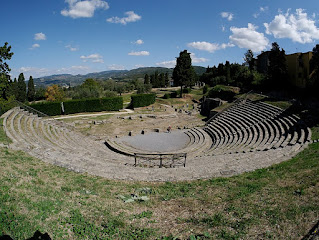The tempestuous life of a talented Tuscan artist
.jpg) |
| Vincenzo Camuccini's portrait of Malenchini, from about 1815 |
Matilde was born into the Meoni family and married the painter and musician Vincenzo Francesco Malenchini at the age of 16. Although they soon separated, she kept his name for the rest of her life.
In 1807 she went to study at the Accademia di Belle Arte in Florence under the guidance of Pietro Benvenuti. To earn money and practise her art, she copied the works of old Italian and Dutch masters in the Uffizi Gallery in Florence.
After being given a four-year annual stipend by Elisa Bonaparte, the Grand Duchess of Tuscany, in 1811, Matilde went to Rome to study at the Pontificia Accademia romana delle belle arti di San Luca. There she met the French Governor of the Papal States, General Francois de Mollis, who was an art collector. He bought 18 of her paintings and helped her establish a studio in the convent of Trinità dei Monti.
While painting church and convent interiors, she worked with students from the Academie Francaise who were living in the Villa Medici, as well as the up-and-coming Italian artists Antonio Canova and Vincenzo Camuccini. In 1815, Matilde was named a Professor of Merit at the Accademia di San Luca and in the same year Camuccini painted her portrait. The years she spent in Rome proved to be the most productive of her career.
 |
| Malenchini's own portrait of the writer Louis de Potter, her long-time partner |
In 1820, Matilde had to leave Rome and she returned to Florence where she was named an honorary professor at the Accademia.
De Potter returned to Bruges in 1823 to be with his ailing father, but the following year, after his father’s death, he moved to Brussels and invited Matilde to join him. Their home in the Belgian capital became a meeting place for expatriate Italians and political refugees. With their friend Navez, they organised painting classes. Navez also became a prominent advocate for Belgian independence.
Matilde became restless and travelled for a while before returning to live in Florence. De Potter, who was frustrated at not being able to marry her, ended the relationship in 1826. He later married Sophie van Weydeveldt, 20 years his junior, with whom he had four children.
Although De Potter agreed to give Matilde an annual pension of 1200 francs, the money was spasmodic because of his political problems. He served 18 months in prison after writing a pamphlet denouncing King William I of Belgium and then went into exile in Germany. Matilde turned to portrait painting to make money to keep herself. There was no contact between her and De Potter until 1854, when he wrote her an affectionate letter following the death of his son, and afterwards they maintained contact with each other through letters.
The following year, by which time Matilde was 76, she was accused of pushing one of her maids out of a window after she caught her stealing. She was sentenced to three and a half years detention but the ruling was overturned. However, it was reinstated in 1857 and sadly, one of Matilde’s last paintings was of the interior of the prison in Florence. She died in 1858 in Fiesole in Tuscany at the age of 78.
 |
| Livorno, the Tuscan port city where Malenchini was born, has a network of canals |
Livorno, Malenchini’s birthplace, is the second largest city in Tuscany, with a population of almost 160,000. It has a large commercial port and in many respects is the most modern city in the region, yet there are also many remnants of its history. Designed by the architect Bernardo Buontalenti at the behest of the House of Medici at the end of the 16th century, Livorno was conceived as an "ideal city" of the Italian Renaissance. Notable are the huge Fortezza Vecchia - the Old Fortress - which was built to protect the port, the fortified walls around the city’s pentagonal plan and the dense network of canals, a kind of “Little Venice”, which were originally created to connect the merchants’ residences with their warehouses. The city has produced many notable painters, including the 19th century landscape and battlefield painter Giovanni Fattori, and the celebrated modernist painter of portraits and nudes, Amedeo Modigliani. It was also home to the opera composer, Pietro Mascagni.
 |
| The remains of a Roman theatre on a hillside near the town of Fiesole in Tuscany |
Fiesole, where Malenchini died, is a town of about 14,000 inhabitants occupying an elevated position about 8km (5 miles) northeast of Florence. Since the 14th century, it has been a popular place to live for wealthy Florentines and even to this day remains the richest municipality in the city. Once an important Etruscan settlement, it was also a Roman town of note, of which the remains of a theatre and baths are still visible. Fiesole's Romanesque cathedral, built in the 11th century, is supposedly built over the site of the martyrdom of St. Romulus. In the middle ages, Fiesole was as powerful as Florence until it was conquered by the latter in 1125 after a series of wars.
Also on this day:
1596: The birth of violin maker Nicolò Amati
1911: The birth of composer Nino Rota
1917: The death in World War One of cycling champion Carlo Oriani
1937: The birth of actress Angela Luce
1947: The birth of politician Mario Borghezio